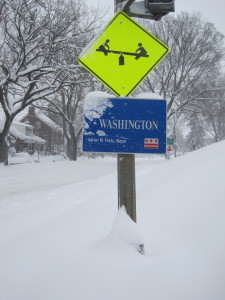We have much more to do and your continued support is needed now more than ever.
Seattle Snowmageddon, Climate Change and Wacky Weather

The storm descended upon us here in NWF’s Seattle office early Wednesday morning and covered much of Western Washington in a blanket of fluffy white mixed with a treacherous layer of slick ice. The storm has been severe enough to knock out power to hundreds of thousands of homes in the area and for Governor Gregoire to declare a state of emergency.
Seattle residents are well known for our inability to cope with severe weather such as snow (I have spent much of my adult life defending the city’s reputation when it shuts down under 2 inches of snow). Even if the snow does not in fact cause the world to end, the extreme snowstorms do illustrate what scientists are talking about when they link more wacky weather to global warming.
Snowmageddon and Global Warming
For many people the term global ‘warming’ indicates that we would see fewer and less severe winter storms. Climate skeptics point to some of these unusual snow events to increase doubt about global warming.
However, warmer average temperatures actually cause more snow in some regions, not less. Take the Great Lakes, for example. Warmer weather keeps the lakes from freezing, which puts MORE moisture in the air that then falls as MORE snow.
Snowmageddons, however, could influence how people think about global warming in a different way. After the 2010 snow event in Washington, DC, researchers at Columbia University decided to see how weather impacts our ideas about global warming. They found that the day to day weather that we experience, such as severe snow storms, does have a significant impact on how we view global warming. Warmer weather was found to increase people’s concern about global warming and its impacts. To read more check out the Huffington Post article.
Weather is not Climate
What we see day to day in events such as ‘Snowmageddon’ is weather. This is what the planet chooses to throw at us each day including heat waves, rain, snow or hurricanes. Climate, on the other hand, is the long term trends that we see. We will continue to have cold snaps and unusual snow events like this, but overall temperatures continue to rise due to global warming pollution.

Just as one or two hot events do not prove the global warming is happening neither do these cold events prove that it is not. What does prove that global warming is happening and that it is caused by humans is the overwhelming scientific evidence.
Want to keep in touch with us here in the Seattle NWF office? Connect with us on Facebook for more information on global warming and other issues facing the nation’s wildlife and wild areas!




















